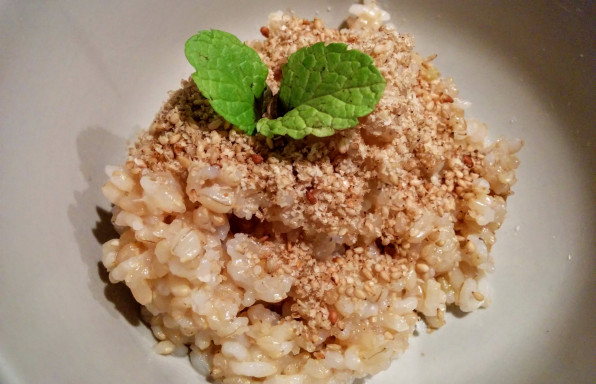
Brown rice has a nutritional value far superior to refined rice, especially in terms of vitamin B and protein. Excellent food for intellectual and spiritual development.
[bscolumns class=”one_fourth”][/bscolumns][bscolumns class=”one_fourth”] Preparation: 10 min[/bscolumns][bscolumns class=”one_fourth”] Total time: 1 h[/bscolumns][bscolumns class=”one_fourth_last”][/bscolumns][bscolumns class=”clear”][/bscolumns]
INGREDIENTS:
- 1 cup organic brown rice
- 1’5 cup filtered water
- Unrefined sea salt
- A piece of kombu seaweed about 2 or 3 cm (optional)
- Gomasio (optional)
- Parsley (optional)
PREPARATION:
-
Place the rice, previously soaked (for several hours or overnight) and the water in a pressure cooker.
-
Add a pinch of salt or a piece of 2 to 3 cm kombu seaweed strip.
-
(Optionally) The rice can be slightly toasted until lightly brown and it releases a pleasant smell.
-
After, add water and bring to a boil, add salt and simmer about five minutes before closing the pot.
-
When the valve has gone up, lower the flame and put a flame diffuser under the pot (if you’re cooking with gas or wood).
-
Allow to cook for about 45 minutes over low heat.
-
After, turn off the heat and let the pressure go down naturally. Open the lid, take the rice and place on a wooden bowl.
-
You may cover it with a damp cotton cloth.
-
Serve with a teaspoon of gomasio sprinkled on top or with chopped parsley.
Physically, it benefits the lungs and large intestine and is very effective in controlling diabetes. If used in excess (or almost exclusively) it can produce an exaggerated thinness, a yellowing of the skin and a too serious expression.
You can simply have it with vegetables or in vegetable broths and even desserts and is much tastier if cooked in a pressure cooker.
It is advisable to always leave to soak before cooking, because it is not only tastier, but also helps the phytic acid to disipate, making the absorption of various trace elements easier (e.g. zinc)
You can also try the following combinations:
- 70-80% 20-30% rice with barley, millet, corn or wheat.
- 70-80% 20-30% of rice or bulgur or ground corn.
- 85-90% 10-15% rice with azuki, black soy seeds, beans, other legumes or nuts.
- 85-90% 10-15% glutinous rice with azuki or black soybean seeds.






